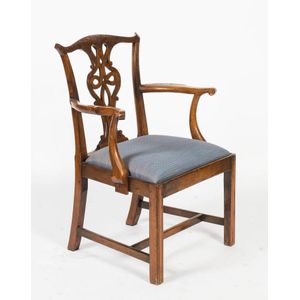French Charles X Mahogany Armchair with Floral Tapestry Seat
19th century French Charles X mahogany armchair, with a curved back rail, flanked by carved acanthus motifs, above a fine and elegant carved and pierced centre splat displaying scrolled acanthus, flanked by a pair of scrolled arms and scrolled acanthus supports, with floral tapestry seat, on turned legs. Purchased: Harlequin Antiques
You must be a subscriber, and be logged in to view price and dealer details.
Subscribe Now to view actual auction price for this item
When you subscribe, you have the option of setting the currency in which to display prices to $Au, $US, $NZ or Stg.
This item has been sold, and the description, image and price are for reference purposes only.
- Acanthus - A stylized leaf motif, one of the primary decorative elements of classical Greek and Roman architecture, derived from the genus of flowering plants in the family Acanthaceae, native to tropical and subtropical regions of the Mediterranean area. It is a common element in classical Greek and Roman design, and is often seen in Corinthian and Composite order columns and used as a decorative element in English, European and Australian furniture, particularly on the curve of a leg, and as decoration for a corbel.
- Rail - A term used by cabinet makers for the horizontal sections of the frame of an item such as a chair or settee which have a front rail, a back rail and two side rails, and also on a door or carcase, where the rails are joined to the vertical framings.
- Pierced Decoration - Ornamental woodwork with part of the background cut through and removed to produce an open-work pattern.
- Splat - The central back support between the top rail and the seat in chairs and couches. They may take a variety of forms, and run either horizontally or vertically.
- Turning - Any part of a piece of furniture that has been turned and shaped with chisels on a lathe. Turned sections include legs, columns, feet, finials, pedestals, stretchers, spindles etc. There have been many varieties and fashions over the centuries: baluster, melon, barley-sugar, bobbin, cotton-reel, rope-twist, and so on. Split turning implies a turned section that has been cut in half lengthwise and applied to a cabinet front as a false decorative support.
- Mahogany - Mahogany is a dense, close grained red-coloured timber from the West Indies and Central America. It was first imported into Europe in the the early 18th century and its use continued through the 19th century. It was popular for furniture making because of its strength, the wide boards available, the distinctive grain on some boards, termed flame mahogany and the rich warm colour of the timber when it was polished.. The "flame" was produced where a limb grew out from the trunk of the tree, and this timber was usually sliced into veneers for feature panels on doors, backs and cornices.
Some terms used to describe mahogany relate to the country from which it originally came, such as "Cuban" mahogany, "Honduras" mahogany etc. However unless the wood has been tested the names assigned are more a selling feature, rather than a true indication of the timber's origin. - Turned Legs - are legs which have been turned on a lathe. In use from the 16th century, turned legs on tables, chairs and cabinets became more frequent until, by the 1830s, the Georgian square or tapered leg was rarely found except in country pieces.
This item has been included into following indexes:
-
chairs, singles / pairs / threes, style or period
- armchairs 1,767
- French 962
- Victorian, other styles 1,208
- chairs, singles / pairs / threes, timber - mahogany 1,120
Visually similar items

A Georgian mahogany armchair English, circa 1800, with floral upholstered seat.
Sold by
in
for
You can display prices in $Au, $US, $NZ or Stg.

A George III mahogany carver chair, English circa 1760. 95 cm high, 70 cm wide, 48 cm deep. Provenance: Private Collection, Melbourne
Sold by
in
for
You can display prices in $Au, $US, $NZ or Stg.

Chippendale style mahogany elbow chair 19th century, maroon leather upholstery and stud work, height 93 cm
Sold by
in
for
You can display prices in $Au, $US, $NZ or Stg.

A George III carved mahogany elbow chair, English, circa 1780
Sold by
in
for
You can display prices in $Au, $US, $NZ or Stg.
